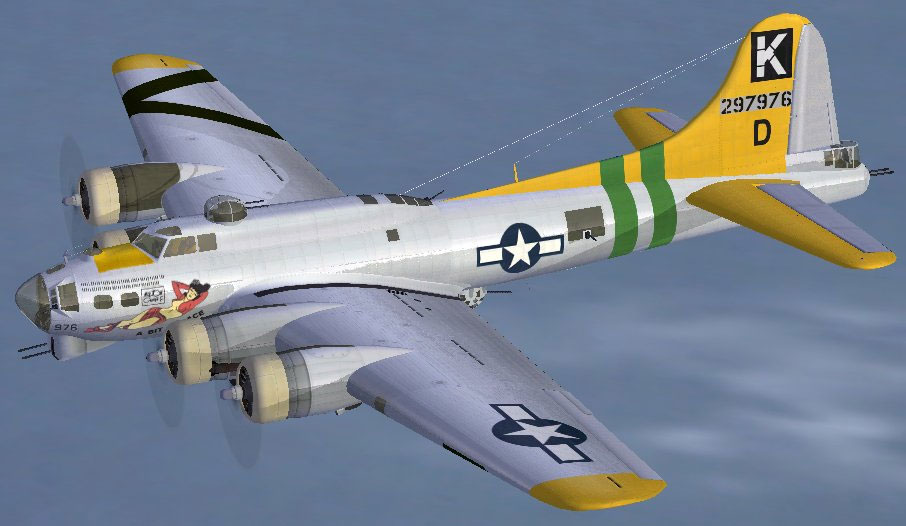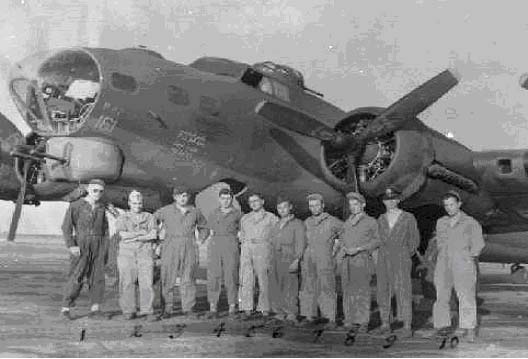Johnsons Corner
Crew
| L/T. H. Johnson | Pilot |
|---|---|
| L/T. H Whitley | Co-Pilot |
| L/T. G. Nye | Bombardier |
| L/T. W. Francher | Navigator |
| Sgt. J. Higgins | Radio Operator |
| Sgt. K. Zeiger | Left Waist Gunner |
| Sgt. E. Williams | Right Waist Gunner |
| Sgt. P. Bartkus | Tail Gunner |
| Sgt. F. Hazzard | Engineer and Gunner |
| Sgt. P. Simpson | Bail Turret Gunner |

Boeing B-17G of the 447th Bombardment Group. 8th Air Force. Based at Rattlesden (UK) in early 1945.
Specification
| Type | 10-seat long range, medium bomber/reconnaissance aircraft |
|---|---|
| Powerplant | (B-17G): four 1,200bhp(895-kw) turbocharged, Wright R-1820 97 Cyclone radial piston engines |
| Performance | Maximum speed 287mph (462km/h) at 25,000ft (7,620m) |
| Weights | Empty 36.135lb (16,391kg); maximum take off 65,500lb (29,710kg) |
| Dimensions | Span 103ft 9in (31.62m); length 74ft 4in (22.66m); height 19ft 1in (5.82m); wing area 1.420sqft (131.92m2) |
| Armament | 13 0.50in (12.7mm) machine-guns; plus up to 17,600lb (7,983kg) of bombs |
| Operators | RAF. USAAC/USAAF |
Lt W. Johnson. U.S 8th A.A.F
The memorial was erected and established to honour the memory of the 23 year old 1st Lieutenant William H. Johnson of the U.S.A.A.F. who sacrificed his life on Thursday 13 April 1944 to save his crew and the residents of Hamstreet.
William was the pilot of a Boeing B-17 Flying Fortress of the 711th Bombardment Squadron, 447th Bombardment Group, United States Army Air Force. At the time of his death William’s squadron was based at Rattlesden, Bury St.Edmunds, Suffolk.
Lt Johnson and his crew was one of 243 B-17’s which were taking part in a raid to bomb the Messerschmitt aircraft plant at Augsburg in Bavaria southern Germany. When flying in formation, their position was no. 4 in the lead squadron.
Approximately 100 miles from the French coast the bombers came under heavy, accurate flak fire which caused a number of planes to abort and head home, including William’s aircraft having suffered heavy damage.
Once the Flying Fortress was over the Kent coast at Hythe, William ordered his crew to bale out from their stricken aircraft, but he took decision to attempt to crash land his aircraft. As he crossed the Romney Marsh and approaching the village of Hamstreet, William realised that his B-17 was going to crash into the village, and in order to avoid the inevitable loss of life amongst the local population, he sacrificed his own life by crashing the huge bomber to the south of the village.

After the crash Technical Sergeant Frank J. Hazzard, of 2541Belden Avenue, Chicago, Illinois, U.S.A., submitted the following report.
For about twenty minutes after we hit the French coast and were well on our way to Augsburg everything went along smoothly but then suddenly all hell began to break loose. A terrific explosion sounded directly beneath my turret, I knew we had been hit pretty badly because I heard the co-pilot saying that he was going to feather number four engine and that number three was out also. The power line in my top turret was hit also, rendering my guns useless. All four officers had been wounded by the flak so I proceeded to the cockpit to see if there were anything I could do. The co-pilot had been hit in the arm rather badly; I cut his sleeve open and bandaged his wrist and arm. The pilot had been hit also in the back of the neck but he told me to take care of the navigator first. I then went to the nose of the ship and saw that the navigator had been hit in the leg. I slit open his trouser leg; the wound was bleeding very badly and I knew he must have been in great pain but all the time I was working on his leg he stood up and continued to navigate the ship. The bombardier had also been hit in the arm but the cut was not bleeding so I figured that he would be OK. About this time the co-pilot called and asked me to transfer the fuel from number four to number one engine. This done I proceeded to throw all my ammunition and ammunition boxes, flak helmet, and other moveable equipment out of the plane in order to lighten the load. I went to the nose and did the same thing there. About this time we were hit again and number one engine went out. We were flying on one engine and losing altitude and flying speed all the time. I guess we were in a pretty bad spot but I was too busy running from my turret to the nose to the cockpit and back again to think too much about it. “Down in the nose I put another bandage on the navigator’s leg. By this time I knew the leg must have been paining him horribly but he still continued to navigate the ship. He did a wonderful job, in my opinion he deserves a lot of the credit for getting us home. When we hit the channel we were flying at 8,000 feet, when we finally reached the English coat we were at 1500 feet. Just as I was thinking that we were going to make it back home in one piece, I felt the ship vibrating something awful, looking out of my window I saw that she was on fire. I was in the nose at the time, tapping the navigator on the shoulder I showed him the fire. He nodded his assent.
I then went back to the pilot’s compartment, I saw the Bombardier on the catwalk of the bomb bay looking for his chute. I remembered that he had left it in my turret position so I immediately went there and got the chute since the Bombardier because of his wounded arm couldn’t get the chute on I snapped it on for him and assisted him in getting out of the plane through the open bomb bay. By this time I thought everyone outside of the pilot and myself had left the ship, I looked towards his seat and saw him getting up preparing to jump. Later on I found out that he had never gotten out of the plane but had been killed when it crashed about a half mile from where I jumped. We were now at 800 feet so I figured it was high time for me to get the hell out of the plane. I went out through the bomb bay. When I landed I saw the co-pilot a few feet away. The first thing he said to me was, ‘Combat’s rough, you can get hurt at this sort of thing.’ It struck me very funny at the moment but I guess there’s nothing very humorous about what we went through. If it hadn’t been for the courage and skill of our pilot in bringing the ship home the wreck it was on one engine; and for the wonderful job done by our navigator even though he was in constant pain and weak through loss of blood, we never could have made it back.
It is believed that Lieutenant Johnson saw the village coming up and sat back in his seat to bring the crippled bomber down away from Hamstreet.
The crew were very saddened at the loss of Lt. Johnson, as they know he gave them priority. Lt Johnson was nominated for the Congressional Medal of Honour and was awarded the D.S.C posthumously.
During the mid 1990’s the village of Hamstreet finally got a bypass, during the construction of which a new road junction was formed on land owned by J.W. Goddard & Sons of Ham Mill Farm, Hamstreet, who also owned the ground where William had died on Thursday 13 April 1944. The above road junction was named Johnsons Corner in remembrance of William H. Johnson.
Contact: Vince Watkins 01233 732678